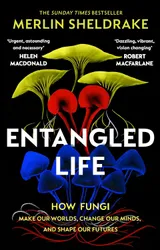The fungi that we usually see in our world, such as mushrooms sprouting from the ground, are really just the fruiting bodies of much larger organisms that extend, often for considerable distances, underground. This book aims to shed light on these and other fungi, to show us how important they are within our ecosystems, and to show how their behaviour has affected human life and development.
One of the most fascinating chapters for me was on lichens. I already knew that a lichen is a symbiosis between a fungus and a photosynthesising organism (either bacteria or algae, depending on the type), but this book explains that there is much more going on with lichens, with other symbiotic partners involved. It also expresses the idea that the discovery of the symbiosis within lichens was a key factor in scientists coming to understand other forms of symbiosis in nature, such as the mitochondria in our cells, and the understanding that bacteria within our guts are performing useful roles. Fungi of many different types engage in a range of symbiotic and parasitic relationships with other organisms, and are parasitised themselves sometimes. In fact, the book makes the case that symbiosis and parasitism are fluid concepts and that there is often no clear delineation between them. Fungi then cause us to question our assumptions about how the world works by blurring the lines between different categories that we thought were separate.
I was impressed by the abilities of fungi in breaking down various types of matter to extract the nutrients. This is the role of the fungus in a lichen, extracting minerals from rocks that the photosynthesising partner needs and cannot extract themselves. It’s also the role that fungi play in woodland, breaking down the lignin in fallen trees and branches, providing nutrients for growing plants. Towards the end of the book, fungal possibilities for the clean-up of human pollution and waste are explored, and there’s an extraordinary photograph of a fungus that has been trained to digest cigarette butts, sprouting a mushroom from a jar of these butts.
Another aspect of the fungal world is its impact on human development. I was very interested to learn that the enzyme humans have for metabolising alcohol is shared by the great apes, suggesting that it arose in the common ancestor of all the great apes. It’s hypothesised that the genetic mutation that resulted in this ability was useful because it allowed the consumption of rotting fruit, in which some of the sugar had been turned into alcohol by yeasts. Being able to eat this fruit then opened up a new source of calories. As humans, we now use yeast to make alcoholic drinks and to make bread rise, and you could argue that we are in a symbiotic relationship with such yeasts. Another chemical that affects our brains is the psilocybin produced in certain types of mushroom, causing psychedelic effects. Here the author’s personal connections to some of the proponents of the use of psilocybin and LSD in psychotherapy show through, and this is perhaps presented a little uncritically. It did make me curious to learn more though.
Beyond the direct effects of fungi themselves, or the chemicals they produce, are the aspects of their behaviour and operation that we may be able to learn from. The mycelial networks that roam underground, seeking out food and transporting nutrients around, can give us new insights into how networks operate, including our brains. Fungi don’t have brains, but they do seem to make intelligent decisions about where to go and what to do. And there is evidence that the mycelial networks beneath forests may provide some communication benefit to the trees above.
I really enjoyed reading this book. It took me into a world I hadn’t thought much about before and was interested to learn about. At times it veers a little bit into pro-fungus propaganda though, such as when the author talks about psilocybin as a psychological treatment, or the use of fungi to process waste and pollution. You could come away believing that fungi are the solution to all our problems, when I’m sure the reality is a little more complicated. But generally it does a good job of conveying the importance of the role fungi play in our world and is a very eye-opening introduction to the subject.
